Banksia densa is a species of column-like shrub that is endemic to Western Australia. It has deeply serrated to pinnatifid leaves, creamy yellow flowers in heads of up to seventy-five, and hairy follicles.
Banksia tortifolia is a small, spreading, prostrate shrub that is endemic to the southwest of Western Australia. It has short underground stems, pinnatipartite leaves with sharply-pointed, linear lobes on each side, greenish-cream, yellow and pink flowers in heads of about eighty, and glabrous, egg-shaped follicles.
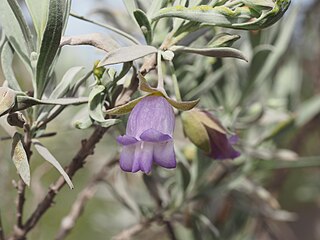
Eremophila maitlandii, commonly known as Shark Bay poverty bush, is a flowering plant in the figwort family, Scrophulariaceae and is endemic to Western Australia. It is a silvery-grey shrub with linear leaves and lilac-coloured to light purple flowers and is common in coastal areas between Shark Bay and Carnarvon.

Patersonia fragilis, commonly known as swamp iris or short purple-flag, is a species of flowering plant in the family Iridaceae family and is endemic to eastern Australia. It is a tufted perennial herb with linear, cylindrical leaves and pale violet to blue-violet flowers.
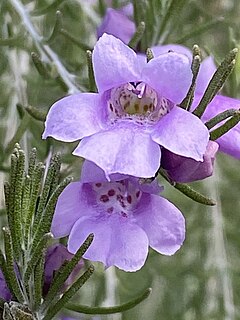
Eremophila microtheca, also known as heath-like eremophila, is a flowering plant in the figwort family, Scrophulariaceae and is endemic to Western Australia. It is an erect shrub with densely hairy branches and leaves, narrow leaves and pale lilac-coloured flowers and which emits a strong odour.

Beaufortia incana, commonly known as grey-leaved beaufortia, is a plant in the myrtle family Myrtaceae, and is endemic to the south-west of Western Australia. It is a shrub with crowded leaves that appear whitish due to their covering of fine, soft hairs on both surfaces. It has almost spherical heads of red flowers in spring.
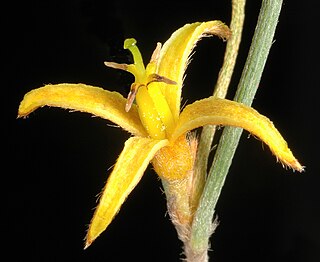
Persoonia angustiflora is a species of flowering plant in the family Proteaceae and is endemic to the south-west of Western Australia. It is an erect shrub with hairy branches and leaves, linear, more or less cylindrical leaves and yellow or greenish yellow flowers arranged singly or in groups of up to four.
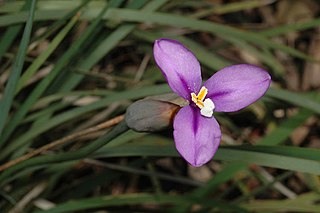
Patersonia occidentalis, commonly known as purple flag, or long purple-flag, is a species of flowering plant in the family Iridaceae and is endemic to southern Australia. It is a tufted, rhizome-forming perennial with narrow, sharply-pointed, strap-like leaves, egg-shaped, bluish violet sepals and a cylindrical capsule. The Noongar name for the plant is komma.

Pityrodia hemigenioides is a flowering plant in the mint family Lamiaceae and is endemic to the south-west of Western Australia. It is a spreading shrub with densely hairy branches and leaves, and pale white flowers near the ends of the branches.

Petrophile semifurcata is a species of flowering plant in the family Proteaceae and is endemic to an area near the west coast of Western Australia. It is an erect, bushy shrub with sharply-pointed, needle-shaped, sometimes lobed leaves and oval heads of silky-hairy, whitish, lemon-yellow or cream-coloured flowers.

Goodenia arthrotricha is a species of flowering plant in the family Goodeniaceae and endemic to south-western Western Australia. It is an erect perennial, herb with linear to lance-shaped leaves with the narrower end towards the base, racemes of blue flowers with linear bracteoles at the base, and oval fruit.
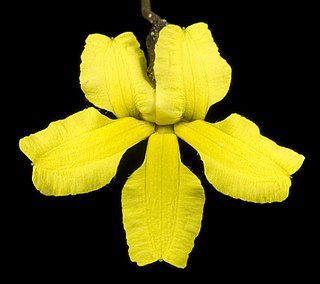
Goodenia concinna is a species of flowering plant in the family Goodeniaceae and endemic to coastal area of southern Western Australia. It is a perennial, herb with linear to lance-shaped leaves, and racemes of yellow or cream-coloured flowers.
Goodenia trichophylla is a species of flowering plant in the family Goodeniaceae and is endemic to the southwest of Western Australia. It is an erect to ascending herb with sticky or shiny, linear leaves at the base of the plant and racemes of blue flowers.

Hibbertia desmophylla is a species of flowering plant in the family Dilleniaceae and is endemic to the south-west of Western Australia. It is a sprawling or erect, hairy shrub with spreading, densely clustered, linear leaves and yellow flowers with eleven to thirteen stamens.
Pultenaea rotundifolia is a species of flowering plant in the family Fabaceae and is endemic to the south of Western Australia. It is a straggling, spreading shrub with flat, glabrous leaves, and yellow flowers with red markings.
Patersonia argyrea is a species of plant in the iris family Iridaceae and is endemic to Western Australia. It is a tufted perennial herb with linear, sword-shaped leaves and violet tepals.
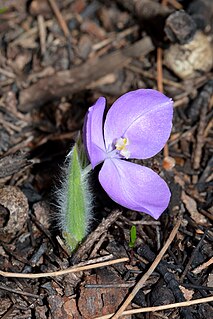
Patersonia babianoides is a species of plant in the iris family Iridaceae and is endemic to the south-west of Western Australia. It is a tufted, rhizome-forming herb with soft, linear to elliptic leaves and blue-violet tepals on a relatively short flowering scape.
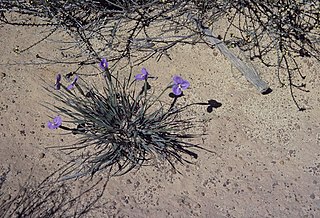
Patersonia drummondii, commonly known as Drummond's patersonia, is a species of plant in the iris family Iridaceae and is endemic to the south-west of Western Australia. It is a tufted herb with linear, often twisted leaves and pale violet to purple or blue tepals.

Patersonia glabrata, commonly known as leafy purple-flag, or bugulbi in the Cadigal language, is a species of flowering plant in the family Iridaceae family and is endemic to eastern Australia. It is a perennial herb or subshrub with linear leaves and pale violet flowers.
Patersonia inaequalis, commonly known as unequal bract patersonia, is a species of plant in the iris family Iridaceae and is endemic to a restricted part of the south-west of Western Australia. It is a tufted herb with linear, often twisted leaves and white tepals.














